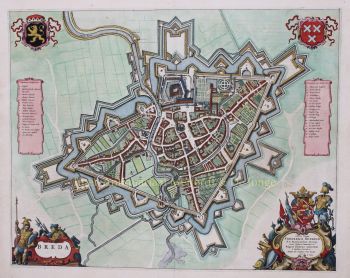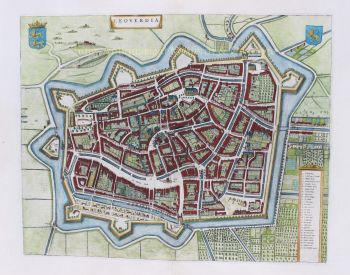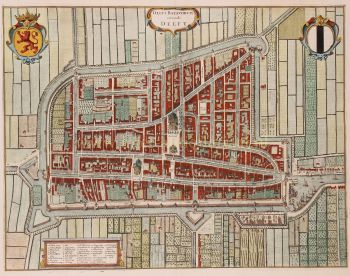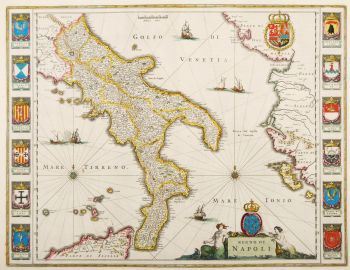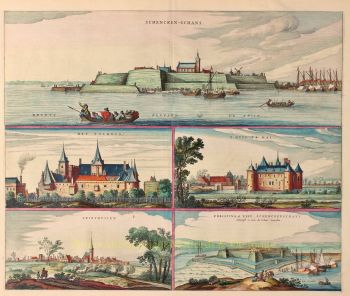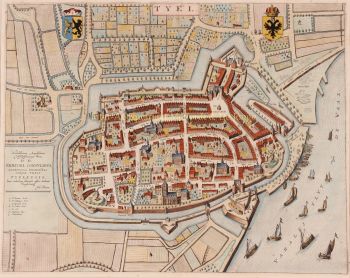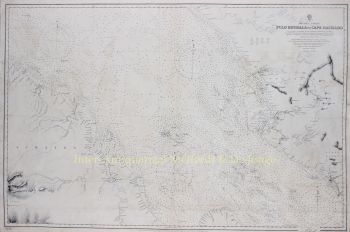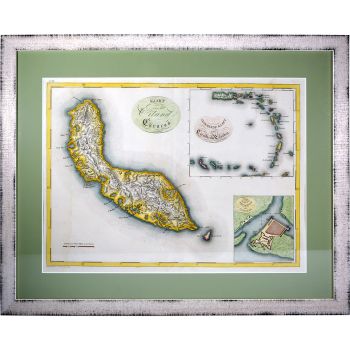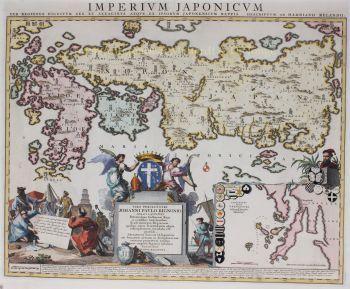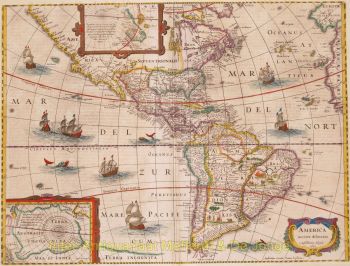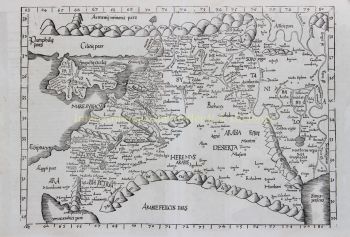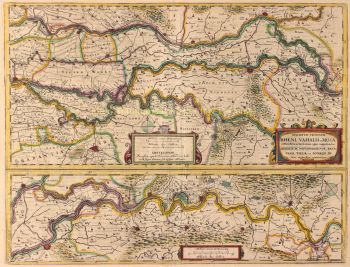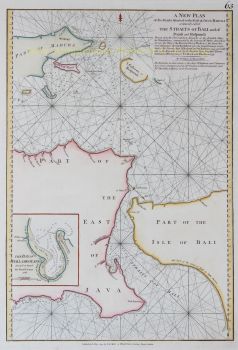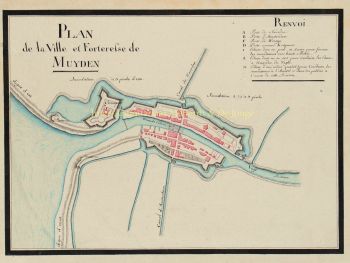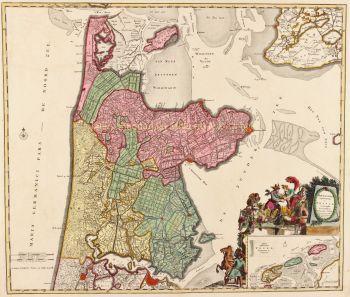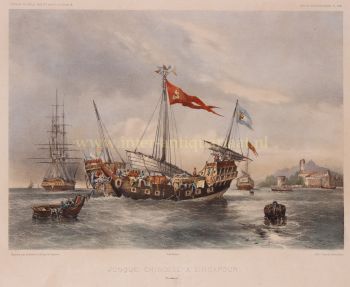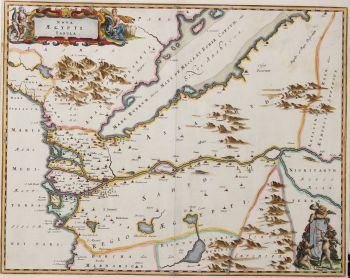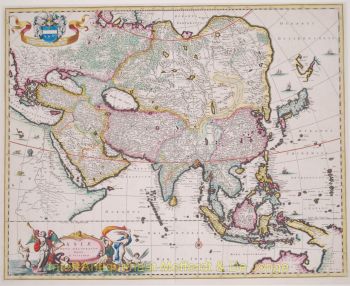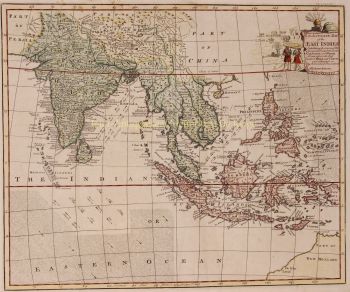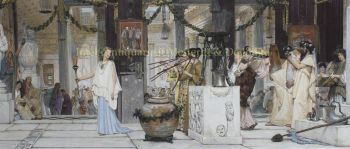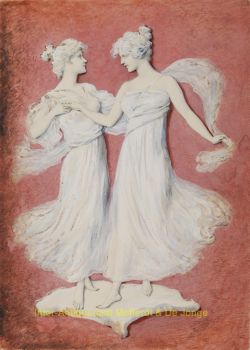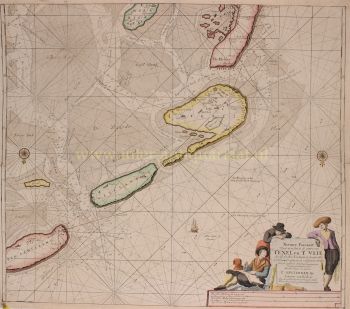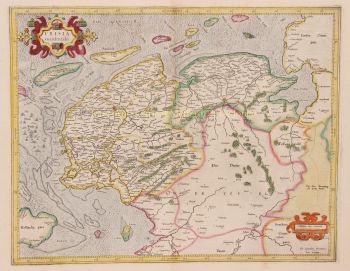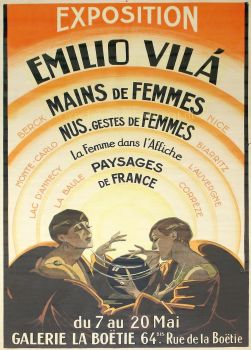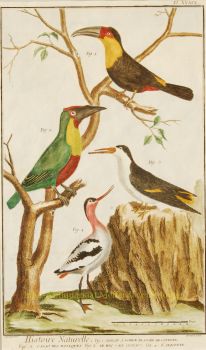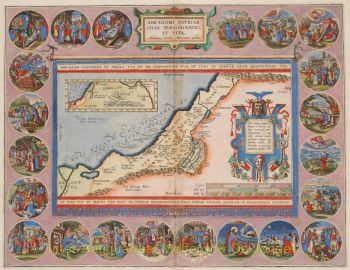Graafschap Zutphen 1658 - 1672
Joan Blaeu
€ 750
Inter-Antiquariaat Mefferdt & De Jonge
- About the artworkMOOISTE KAART VAN HET GRAAFSCHAP ZUTPHEN, ÉÉN DER KWARTIEREN VAN GELDERLAND "Zutphania comitatus, Sive Ducatus Gelriae Tetrarchia Zutphaniensis", kopergravure uitgegeven door Joan Blaeu als deel van de Atlas Mayor, tussen 1658-72. Verso: Spaanse tekst. In de tijd met de hand gekleurd. Afm. 42 x 52,5 cm. Het hertogdom Gelderland en het daarmee verbonden graafschap Zutphen omvatte enerzijds het gebied van de huidige provincie Gelderland en anderzijds het noorden van Limburg (met onder meer Venlo, Venray en Roermond), evenals het aangrenzende zuidelijk deel van de Duitse Kreis Kleef. Om het titelcartouche linksboven staan drie engeltjes en twee blanco wapenschilden. Rechtsboven het wapen van de Graafschap Zutphen. De kompasroos aan de rechterzijde duidt dat het noorden boven ligt. Linksonder zien we de schaalaanduiding in een met engeltjes en landmeetapparatuur versierde cartouche. Rechtsonder de wapenschilden van de steden Zutphen, Doetinchem, Doesburg, Lochem, Bronckhorst, Groenlo, 's Herenbergh, niet ingevuld zijn Borkelo, Bredevoort, Lichtenvoorde, Aenholt. Ook zien we nog een beknopte legenda bij de linkerrand. Blaeu was bevlogen een atlas te maken zoals nog niet eerder op de wereld vertoond.Hij wilde iets creëren dat in de hoogtijdagen van de macht van Amsterdam de geciviliseerde wereld zou overdonderen. Het werd zijn magnum opus dat uiteindelijk ca. 600 kaarten en ca. 3000 tekstpagina's bevatte, een boekwerk in negen banden met uitgaven in het Nederlands, Latijn, Frans, Duits en Spaans. Het werd de grootste wereldatlas ooit gepubliceerd. De verschijning ervan vormt de bekroning van de gouden eeuw van de Nederlandse cartografie, een tijdvak van ongekende bloei, dat samenvalt met de enorme opleving van de handel en de daarmee gepaard gaande rijkdom en welvaart in vooral de eerste helft van de zeventiende eeuw. De Groote Atlas van Blaeu was het meest kostbare gedrukte boek dat je in de tweede helft van de 17de eeuw kon kopen. Prijs: Euro750,-
- About the artist
Joan Blaeu (1596-1673), was born on the 23rd of September in 1596 in Alkmaar.
He was a Dutch cartographer born in Alkmaar. He followed the footsteps of his father, cartographer Willem Blaeu.
In 1620 he became a doctor of law but he joined the work of his father. In 1635 they published the Atlas Novus (full title: Theatrum orbis terrarum, sive, Atlas novus) in two volumes. Joan and his brother Cornelius took over the studio after their father died in 1638. Joan became the official cartographer of the Dutch East India Company.
Blaeu's world map, Nova et Accuratissima Terrarum Orbis Tabula, incorporating the discoveries of Abel Tasman, was published in 1648. This map was revolutionary in that it "depicts the solar system according to the heliocentric theories of Nicolaus Copernicus, which show the earth revolving around the sun.... Although Copernicus's groundbreaking book On the Revolutions of the Spheres had been first printed in 1543, just over a century earlier, Blaeu was the first mapmaker to incorporate this revolutionary heliocentric theory into a map of the world."
Blaeu's map was copied for the map of the world set into the pavement of the Groote Burger-Zaal of the new Amsterdam Town Hall, designed by the Dutch architect Jacob van Campen (now the Amsterdam Royal Palace), in 1655.
Blaeu's Hollandia Nova was also depicted in his Archipelagus Orientalis sive Asiaticus published in 1659 in the Kurfürsten Atlas (Atlas of the Great Elector). and used by Melchisédech Thévenot to produce his map, Hollandia Nova—Terre Australe (1664).
As "Jean Blaeu", he also published the 12 volume "Le Grand Atlas, ou Cosmographie blaviane, en laquelle est exactement descritte la terre, la mer, et le ciel". One edition is dated 1663. That was folio (540 x 340 mm), and contained 593 engraved maps and plates. In March 2015, a copy was on sale for £750,000.
Around 1649 Joan Blaeu published a collection of Dutch city maps named Toonneel der Steeden (Views of Cities). In 1651 he was voted into the Amsterdam council. In 1654 Joan published the first atlas of Scotland, devised by Timothy Pont. In 1662 he reissued the Atlas Novus, also known as Atlas Maior, in 11 volumes, and one for oceans.
A cosmology was planned as their next project, but a fire destroyed the studio completely in 1672.
Joan Blaeu died in Amsterdam the following year, 1673. He was buried in the Westerkerk at Amsterdam.
Are you interested in buying this artwork?
Artwork details
Related artworks
- 1 - 4 / 12
- 1 - 4 / 24
- 1 - 4 / 12



